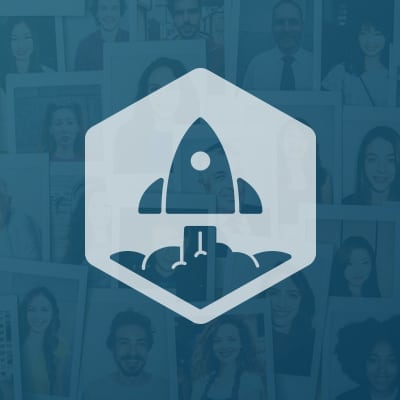Your company has found success with SMBs making up your customer base. The processes are in place and you’re comfortable maintaining relationships with them. But moving to large enterprises is a whole different ball game. How should you think about their sales cycles and cultivating those relationships to ensure these enterprise customers stay with you for many years down the road?
For many founders and CEOs, it starts with the emotional decision and willingness to just go for it, even though the company’s infrastructure and processes may not be 100% “ready” yet.
Should you tell your first enterprise customer that they are the biggest customer to date? How do you tread the murky waters of sales contracts? How should you think about pricing? And how do you determine if a prospect is the right first enterprise customer?
And if you haven’t heard: SaaStr Annual will be back in 2018, bigger and better than ever! Join 10,000 fellow founders, investors and execs for 3 days of unparalleled networking and epic learnings from SaaS legends like Jon Miller, David Steinberg, Jennifer Tejada, and Eoghan McCabe. If you don’t have tickets, there’s still time to grab yours today and bring your team from just $999! (Hurry before they’re all gone!) Get tickets here.
TRANSCRIPT
Announcer: From Salesforce Ventures, Director of ISV Sales, Brooke Gardner.
Brooke Gardner: Good afternoon. Thank you for joining us for “Secrets to Closing Your First Six figure Deal.” I’m Brooke Gardner with Salesforce. I’m joined by John Stewart, CEO and founder of MapAnything, Bob Marsh, CEO and founder of LevelEleven, and Kathy Lord as VP of Customer Success and Sales at Intacct. Thank you all for being here this afternoon and thank you all for joining us.
Let’s go ahead and get things started with some introductions. Can you each share with us a little bit about your role, your company, and some of the growth you’ve experienced this past year?
John Stewart: As you said, John Stewart. I’m the CEO and co founder of MapAnything. MapAnything is an app innovation partner of Salesforce. We are the businessware company, which means we use location as part of business process and workflow to help employees be more productive in their planning and gain efficiency, so really focus on field sales, field service, field marketing.
Bob Marsh: My name’s Bob Marsh, Founder and CEO of LevelEleven. I spent my career, about 20 years, in sales and sales management.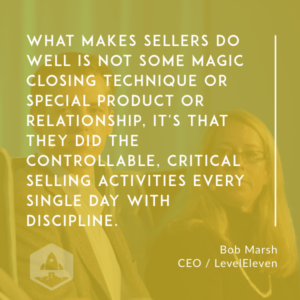
One of the things that I learned as a successful seller and managing other successful sellers is that what made them do well is not from any magic closing technique or some special product or relationship, it’s that they had the discipline to do the controllable activities every single day with discipline that led to success, as I learned.
The problem is that only, maybe, 15 percent of your sales organization actually act that way naturally. Give 100 person sales team, you’ve got 85 people who get lost in customer service issues or writing proposals.
That was a nugget that got me to start LevelEleven. We’re a sales activity management system. We work with companies that help identify the critical selling activities that lead to sales.
Every salesperson gets a personalized scorecard to know where to focus. Sales managers use it to manage their team, run their team meetings, manage their one on ones, etc., that sort of thing.
We work with companies that are here at SaaStr, like Influitive, Sprout Social, SalesLoft, and large enterprises like HP Enterprise, Comcast, Verizon. I heard we just signed Mutual of Omaha this morning.
Our growth over the last year has been very much focused on this topic of larger enterprises. In the last year, we’ve gone from one six figure customer to now we have about a dozen. We recently signed our first quarter million dollar customer. This topic is certainly one that’s been on top of mind for me.
Kathy Lord: Kathy Lord, SVP of Direct Sales and Customer Success for Intacct, as Brooke mentioned. For those of you who don’t know Intacct, it’s cloud ERP for the mid market. We span everything from a couple of million dollar companies all the way up to billion dollar companies.
One of the things that I’ve found that’s very interesting is that I own the entire revenue stream. I’m not only under the gun to sign up those new six figure deals, but I’m actually accountable for making sure we retain those six figure deals for the next 15 years.
It’s a very interesting approach we have in terms of deciding which of those accounts we bring on board as well as how have we scaled up in terms of starting from smaller customers, and then now growing up to supporting billion dollar organizations. I’m really excited about our panel today and talking about some of the things that we live through in terms of trials and tribulations as we figure out how we do that successfully.
Brooke: Thank you, guys, for those interactions. Let’s go ahead and start with you. Tell us about, when do you know that your company is ready to go after your first large six figure deal?
John: Well, you’re ready to go after it when you decide to go after it, but the reality is you’re not actually ready to do your first six figure deal. Like most SaaS companies, I started in the SMB segment, and then climbed up the market segmentation.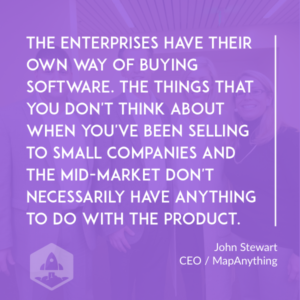
What you’ll find is that, when you get into six figure SaaS deals, it means you’re dealing with the enterprise. The enterprises have their own way of buying software. The things that you don’t think about when you’ve been selling product to these small companies, the mid market, are things that having nothing necessarily to do with the product.
You start getting into, “Here’s our click through license agreement to you.” My first six figure deal was a company with the name First Data. They said, “That’s great. Here’s your 65 page license agreement that we use.” There’s data privacy issues and procurement process, and the things that you don’t have to deal with at a smaller scale.
That was a bit of a change in the way we operated and did business. The lesson learned there is understand early on the answer to the question, which is, “How do you guys buy software?” because, when you attack those, it’s never about necessarily winning the technical end of it. It’s going to be about everything you have to do to actually close that deal.
Brooke: Bob, you want to add anything to that?
Bob: Yeah, I mean I think you’re right. [laughs] You never really feel like you are ready. You certainly want more of it.
When you’re early on in particular, there’s a tendency…you want velocity, of course, and you go after the smaller companies. You think about there’s the ego stroke of the large company and it also validates a lot about your business, but it can be a mind bender when you get things like, “That’s a really nice agreement you have. Here’s ours,” and you go through that process.
You don’t really know if you’re ready or not. You just have to go for it at some point and you’re going to see if you’re ready, so you have to keep shooting at it and maybe you’ll get it, maybe you won’t, but you just have to decide, as you said, that you want to give it a run.
Kathy: The thing I would add to that, and this is such a great structured way to look at it, is you look at what is that customer journey or experience, and how are you then solving it for them and addressing that when you’re dealing with either SMB customers or smaller, and what of that is going to be different as you get bigger?
There’s certainly sales cycle things that are different. Oftentimes, they’re going to want to see you face to face. They’re going to have certainly a different contractual and procurement process, but what we’ve found is dramatically different, is that once you sign them up as a customer, they’re expecting a different level of service in terms of, “How do you train me?
“How do you implement me? What level of support am I going to get? I want a named person I can call and chew out if something is not working on the software. I’m not willing to log on to a portal and enter my case.”
It’s really across that whole buyer’s journey, and since we need to keep that revenue going for many years to come, it’s thinking also beyond just how do you get them to just sign the first contract.
John: That’s such a great point. Again, going back to the first deal that we did, our advocate called me and said, “Hey, we just need to take a look at your service level agreement and escalation process,” I said, “Oh sure. No problem. We’ll send it over.”
[laughter]
John: I hung up the phone, I called my CTO and partner, and I said, “Hey, I think we need to go write a service level agreement and escalation process.”
[laughter]
Bob: When you’re thinking about, are you ready, if you have a sales organization, particularly as a founder, you might have to look and say like, “Are they ready in terms equipped?” They’ll say they’re ready, because they’re going to see big dollar signs, but you do need to decide, “Are they really equipped to handle a customer like this?”
Even if you don’t, like as I said, if we have founders in the room, if you don’t have experience either, then it’s going to be on you to figure it out, but better you to do that than the rep.
Particularly for that first one or those first handful, and probably it will last for a long time, you will need to own that sales process and honestly the larger enterprises will expect it and they’ll value it, too.
You’re going to probably need to take ownership of that, want to learn along the way because there’s little quirks, things like you just mentioned, that will come up through the sales process that nobody in your company would ever have imagined coming up, like your escalation policy.
Only you as the founder are going to have the wherewithal to say, “No problem,” hang up the phone, and then you can actually get that done, like that night.
[laughter]
Bob: Those are some of the things that will happen on many different swings of the sales process.
Brooke: Bob, what are some of these key milestones that you need to achieve as a company before you can go after that large six figure deal?
Bob: I don’t know if there is one. It’s a little bit what John said. Some of it is the emotional decision that you’re ready and that you’re willing to go for it.
You certainly have it in you if you’ve started a company, but if you’ve got other customers, that’s helpful. If you’ve got some kind of a process to follow, so you can understand that’s the process for everyone else, then you have to start thinking about, “How could this work for a larger enterprise?”
As you mentioned, Kathy, a bit, they may expect more in person. They may expect, like we’ve had this recently, “What’s your implementation plan?” “What? What’s that?”
[laughter]
Kathy: “Can someone help?”
Bob: Right. Some of it is like, “Are you ready if you have a process in which you implement and manage to rollout?” OK, you have something, so actually you may have more ready than you possibly realize, so having the basic customers that are using to prove that you’re somewhat ready is certainly one of them.
Brooke: Kathy, once you close that first big deal, how do you get the rest of your organization behind you, and as you were talking to Bob, all the support that you need from your engineers, from your ops team, how do you get them all together to support what it takes to ensure that this big success that you just landed is that?
Kathy: Ideally, you have a little bit of that discussion before you close them, but that rarely happens, because all of a sudden, you’re in the throes of closing this big deal, but the key thing is understanding, what makes that customer a six figure deal? Is it because instead of selling them a five years of departmental license, now all of a sudden, you’ve sold them an enterprise wide license?
Is that scaling up based on a higher volume of users or is it scaled up because you’ve now sold more complex modules or what can drive you there?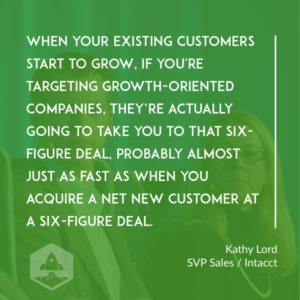
One of the things that I’ve found really helpful is that ideally when you’re selling customers and they’re starting to grow, even though they may be an existing customer, your customers, if you’re targeting growth oriented companies, they are going to actually take you to that six figure deal, probably almost just as fast as when you go acquire a net new customer at a six figure deal.
That was one of the really cool things for us, is that, when I had to go get services, support, engineering, and finance to agree to go as we moved up market and selling bigger deals, I said, “Hey, you know what? I’m going to acquire customers that look like the ones we already have today.
We may have acquired a customer when they were 50 employees and 20 million, but you know what? Now they’re 300 million and hundreds of employees, and so we’re already servicing those customers.”
You look at that and you say, “OK, well, how happy are those customers? Are they the ones that are calling us about support, or they have product issues, or they’re on the red account list every week?” It’s a great way of self reflecting into your install base of how many of those customers are growing or not, and then that can help take you upmarket.
The number one thing that I used was just mapping out, and you’ll hear me keep repeating this, but I think it’s such a great framework, is going through, “Here’s the milestones on that customer’s journey. What are they expecting different, and this is how we’re going to deliver it.”
I was able to lay out a framework of, “This is what it means to engineering, this what it means to services, and did I get everything right the first time? No.” As you go along, you’re going, “Oh. I didn’t expect them to ask for that,” but at least you can get their buy in because it’s now not unknown. You get a framework for what those larger customers are expecting back from you in return.
If folks haven’t sold or worked with larger customers like that, it’s scary because they don’t know what you’re signing them up to do.
Bob: When I think of the implementation, for these bigger customers, that’s different, is that, in any kind of SaaS, you’re trying to build…ideally, you’re hoping for a very frictionless sales process, self service driven, etc., but those bigger ones I was talking about earlier, it just requires something different.
One of the things I know we learned is that for a larger enterprise, you have to have this different mentality for what does implementation and rollout mean, so it’s not just, “Hey, go here and install this, and click these buttons, and here I created this really nice word document with pictures and screenshots.”
There actually needs to be a formalized project plan, implementation plan, “Here’s the start point. Here’s what a kickoff call is, who should be on that call, what are we going to cover?”
All the way through the process, regular escalation to the executive sponsor, make sure that you have that designed out, “Here’s what done looks like, so this is when we are done, and all both of us are in agreement, we’re signing off on that agreement,” but that concept of a project driven implementation was one that was very new for us.
We made plenty of mistakes to learn that one, but that was a big shift and actually a very simple concept that, unless you’ve been burned a couple of times, you don’t really think of it that way. You’re thinking, “Hey, they bought it, they can go install it, and then we’re good,” but it doesn’t really work that way.
John: Again, this being your first six figure deal, it’s going to be an enterprise account. One of the speakers yesterday warned about CEO magic while scaling a company. For your first enterprise account, expect to be doing CEO magic and do a lot of it, and don’t shy away from it.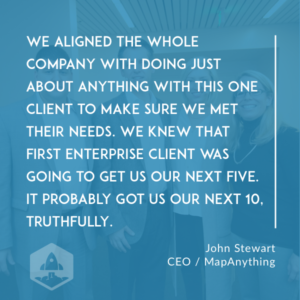
We aligned the whole company about doing just about anything we had to do with this one client to basically make sure we met their needs, and they did roll out and adopt because we knew that first enterprise client was going to get us our next five, and it probably got us our next 10, truthfully.
Also, the one thing that did do for us was, just like the company, from a sales process standpoint, wasn’t really enterprise ready. What you’re going to find is, if you have an SMB and mid market solution and you bring it to that enterprise segment, your solution is probably not ready, either.
Although we did a lot of fire drills, what that first enterprise client did for us is, they made our product bulletproof at an enterprise scale. Up to that point, the most number of records, for example, that we were dealing with in an account was like 100,000 records. Well, this was a financial services company.
They had 30 million account records, so you look at the relative scale, how to deal with it, and they had hierarchy structures on top of hierarchy structures which led us to putting in role based UIs and permissions, so they really got us ready.
The next enterprise account that we went to, we were actually ready to take that deal then a lot better, and our whole company was aligned about it, so the developers never complained when like in the middle of the day, I’d call them up and say, “Add this feature. We need this, do it now.” Everybody was on board with that and that really drove our success in the segment.
Brooke: We’ve got a room full of founders here. What piece of advice would you each give to them on finding and closing that first six figure deal? Kathy?
Kathy: Absolutely. You really need to think about it, and a little bit depends on how you sell your product, and if it’s a matter of scaling up number of users and you’re going from departmental sales, to enterprise wide sales, or selling a bigger footprint of more complexity.
The number one thing, I would say, is to map through what your current process is today, and then map through what you would expect that to change to or to differ so at least you have documented a road map of the things you think you’re going to need to do differently.
Whether or not you have them in place, you at least know where those gaps are, and the great thing about events like this is it’s so easy to document your process and go to a peer and say, “OK, this is what we do today. What do you think we’ve got to do different to go get that first deal and try to make them successful?”
Leverage other people’s trials and tribulations to try to reduce the amount of times you’re banging your head against the wall on it.
Bob: A couple of things. One is, coming back to the same concept of just deciding you’re going to do it, so that first one, I remember after our first couple of years, I just felt like, “We have to get our first six figure customer. We’ve got to figure out a way just to get the first one, any way possible.”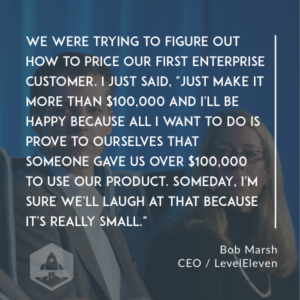
I remember it was a large enterprise and we were trying to figure out how to price. We had no idea, and it seemed that if we used our typical pricing, it would be way up here. I’m like, “I don’t even care. Just make it more than $100,000 and I will be happy, because all I want to do is get a customer and prove to ourselves, our sales team, our product team, our investors, anybody, to say, ‘Someone gave us over $100,000 to use our product,’ and someday, I’m sure we’ll laugh at that because it’s really small.”
You just have to get over that hump of deciding like, “I’m just going to find one,” and then when you get that, it’s like, “All right. Now, the next one, and now I’d like to go after 250,” or whatever it might be. That’s that mental barrier, and sometimes you can get very caught up.
I remember, in using your typical pricing model or calculator for what it would look like and say, “Maybe our first one is going to be $342,000,” it’s like, “Maybe not. Just get your $100,000 and let’s move on, and then if we lose a little bit, it’s OK, but we’ll fix it the next time.” There’s a little bit of that you have to get comfortable with.
The other topic a bit is on the new business front. I touched on it slightly but there’s a lot more preparation work that goes into you get that first meeting, like, “How do I go in, and how am I ready for it?” Preparation doesn’t mean, “I’m going to read all night long about all these people and what they’re saying on Twitter and what they’re saying about the company.”
It’s just there’s a lot of research that goes into it in terms of, you talk to a lot of people. And preparing for that meeting, let me call my sponsors and say, “What do you guys want to get out of this? Tell me what to expect from the meeting. What’s the room like? Tell me about the other people, and what are they looking for, and what do they do?”
It’s just a lot more blocking and tackling on how to prepare for that meeting, go to that meeting and expect to be many more people that you need to deal with, and ultimately when they say yes, that actually doesn’t mean they’re ready to go. It might mean like, “Yes, we want to buy it. It will take six more months to go through procurement, and IT, and security, and everything else.”
You have to also be ready for all those different twists and turns of what it’s like to buy something, because those first meetings aren’t going to be like the typical ones we go in and demo. It’s going to be a lot more complicated, with a lot more people involved in that discovery and sales process.
John: I think you’re spot on. Be prepared that it’s going to take you a lot longer than you think it is.
It’s going to cost you a lot more to service that client than you think it will, and the price, whatever you negotiate with your business sponsor, doesn’t mean a darn thing until you get through the corporate procurement department [laughs] and they get their pound of flesh, which they will.
Bob: Start higher.
John: Start a lot higher.
Bob: Prepare for that.
John: It’s one of those things where it just does come back to that. You’ve got to be ready to go after it, and understand that your job is to make sure you have alignment about taking care of those customers as best as you possibly can because you are going to use that first enterprise client to get your second, third, fourth and fifth, so they’ve got to be a referenceable customer.
Brooke: Thanks, John. At this point, we would like to open it up to the audience for any questions you have for our panelists. Yeah. Go ahead.
Audience Member: [inaudible 20:13]
Brooke: “How transparent should you be to a customer about whether or not they are your first enterprise customer?”
[laughter]
Bob: The pause may be part of the answer. I actually do think that you should. You want them to know that. If you tell them that, then a lot of these bigger companies, they actually like that, and they’re comfortable with that.
Part of your process should be like, “You would be our biggest customer,” or, “This part is new to us,” whatever it might be, “But you’re buying it for this reason and this is what we’re all about. We would like you to be part of helping us design like, ‘What is this product going to look like?'”
“No, you’re not going to own the product but we want to have your input and help guide us because we want to win more customers like you,” then turn it into this opportunity to say, “And in return, what I would like from you is we want product feedback from you but also I want you to be a referenceable customer for us.
Assuming we find success, help me share your success story, and use your name, and use your logo, and all that kind of stuff.” That’s the quid pro quo that comes with it, but it only comes if you’re open and honest, so I think it’s actually really important. If they know that, then they’re going to appreciate the honesty.
They just want to have some sense of, can your business handle them, which is more of what they’re concerned about.
Bob: You can actually use that to your advantage. In some cases, they will take a little bit of ownership and pride to watch you as a company develop as you grow over time.
Like you said, they can’t own the product but know that…The funny thing is, to this day, whenever we were signing a new client that would become now our biggest customer, I continue to tell them that, because I want them to know there is no one more important, no one customer more important than them.
That buys you a lot of weight, a lot of credibility, and you’ve just got to couch it as, “Look, we’re building our whole reputation of our company on you, our first enterprise client, so we’re going to do whatever we have to do to make sure you’re successful. That’s my commitment as the CEO. We’re going to align all our resources,” and I’ve never gotten dinged for that. Not one time.
Kathy: I would say, on that, this is really important when you’re thinking about not just are you ready to close your first six figure deal, but is that prospect the right first six figure deal for you to close?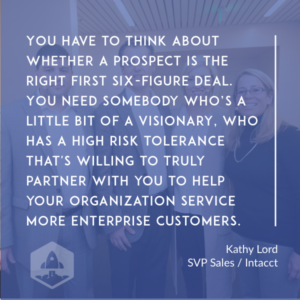
You need somebody who is a little bit of a visionary, who has a high risk tolerance, that’s willing to truly partner with you to help you bring your organization to service those types of customers. If you find the right first one, they can really accelerate your product and your approach to the market.
It can be detrimental if that first six figure deal you close is somebody who has a very low risk tolerance, and probably even more important, isn’t in the sweet spot of what you’re looking to grow and develop the product. If that first six figure company is saying, “Hey, we need features A, B, and C,” but the rest of your market needs X, Y, and Z, you’re on a wild goose chase.
Sometimes, it’s hard to totally assess that before you sign them up, but that’s one of the most critical things when you’re bringing on those first couple is, they have to be right in your wheelhouse so that they can actually take the product where you’re going to be able to go to mass market with it as opposed to some fringes.
Brooke: Thanks, Kathy.
John: Great point.
Brooke: Yes, sure in the back?
Audience: [inaudible 23:59].
[laughter]
John: At the enterprise level, if it’s a real enterprise account, even to this day, I have in house legal counsel now, something I never would have dreamed of having at a software company, but we have to because of our deal flow, and there are certain key things that matter and there are certain things that don’t.
Understand that their lawyers, just like your lawyers are going to do, they’re going to ask for everything under the sun, and the sun.
The things that are really important to a SaaS company, at least what I always tell my CRO and my sales guys, absolutely no IP assignment rights, and these are the ones that are important, guys, and because large enterprise companies will be sneaky about that and try to stick that in there, i.e., you build a feature for them, they own it, or can make an assignment to your software. None of that.
Make sure it’s mutual identification. No, under any circumstance, termination for convenience. This is a nightmare for your auditors.
[laughter]
John: Revenue recognition issues, you don’t want any of those. The no hire clauses are BS and not really enforceable in most states but I focused in on those three main points, and then…
Bob: Those are the three.
John: …the rest of it, it makes my lawyer happy, it makes their lawyer happy, to mark it red, it’s like coloring, so whatever.
[laughter]
John: A lot of those large corporate agreements will follow the same flow. Some of them, if you’re off platform, you do get into the data protection.
If you do anything with healthcare companies, you are going to get into HIPAA provisions and that in itself is its own little nightmare, and there are some bugaboos in there, too, and that’s where your insurance, your limited liabilities, becomes important. Just understand the things that really matter and then don’t worry about the rest of the garbage.
Audience: [inaudible 26:03] .
John: Look, I’m not going to win this argument with a GE or a Siemens, or a Comcast. It’s just the way it is.
Kathy: But I will tell you, we go all the way up to very upper mid market and we just say, “It’s our contract, and if you want to move forward…” We explain to them that the size of organization they are, the amount they are spending with us annually, yes, it is over six figures but at the same time, the risk and exposure for them is minimal and if you want to move forward, this is it.
SaaS is very different than licensing on premise or custom software development, and this is the challenging part is, many times their agreements don’t really give them the protection that they should want to have around service, and availability, and all those things that most Software as a Service contracts cover.
When we have that conversation with them, we can generally get away with it. I agree, when it’s the Boeings, the GEs, you’ve got to use their paper.
Brooke: Go ahead.
Audience: [inaudible 27:07] .
Brooke: The question was, “How do you identify that enterprise account, and how do you identify that decision maker?”
Kathy: Obviously, it’s probably going to be somebody who’s raised their hand and expressed some interest in some way, or if you have a target list of saying, “Hey, we’re going to go spearfishing and we’re going to go try and pick off these key industry leaders because we think that they will be able to be great references for us to bring the others on board.”
You can start to look at them. What are the other technologies do they use? Are they cutting edge? Are they using the latest and greatest in complementary technologies? And that just says a lot from the outside even without having had conversations with them, to know what is their risk level.
Clearly, they’re willing to do that. It’s finding somebody who is in that sponsorship or leadership position that you can quickly do some great LinkedIn searches or similar, to look online and say, “Have they been proponents or spokesmen for other technologies?”
You can really start to assess, “Are there players there that are willing to be advocates to bring new technology and new advantages to the organization?”
Brooke: We have time for one final question. Go ahead.
Audience: [inaudible 28:41] .
Brooke: The question is, “As a startup, how do you ensure to these big enterprise companies that you’re going to be in business two years from now?”
Audience: How do you allay their fears? What do you tell them?
John: For myself, it was easy. We’re built on Salesforce.com. I said, “We’re built on their platform.”
Brooke: Great answer.
[laughter]
John: “I have the world’s best scalability, and availability, and all that other good stuff.”
Brooke: I don’t pay him.
John: She doesn’t. In fact, I pay them.
[laughter]
Bob: Exactly.
John: A lot.
It’s one of those things where you convince them, hopefully, your platform that you’re built on, something like AWS or Salesforce, and that’s a very easy, neat little trick with your legal document that says, “Hey, OK, we disappear, we’ll put something in, it’s called an escrow agreement for software source code.”
We’ve done it six or seven times. It’s never been executed, obviously. It’s almost like a paper agreement, but you can do that and that makes them feel good. It says, “Let’s say, as a company we go out of business, it’s a system of record, they still have the ability to continue to maintain the system and have access to it.”
It’s something that will unlikely never be used because if a company does go out of business, they’re going to switch platforms. They can’t have a system of record on a company that’s out of business, but it is a nice little legal trick that certainly allays those concerns and lets you operate.
Bob: There’s two parts, there’s the technologies, and we’re the same way. Being on Salesforce, instantly, you have the credibility and that issue is put to the side, but then there is the business side of it, which is like, “Yeah, but what if you go out of business and you can’t service us anymore?”
There, I don’t know if there’s a really clear, solid answer other than in some cases, you don’t need to open up all your financials but if they just know, “Hey, here’s where we really truly are, directionally where the business is.”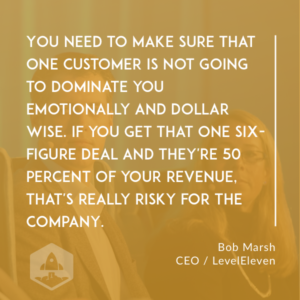
I think also you need to be careful that any one customer is not going to dominate you and not just emotionally but I mean dollar wise. If you get that one six figure deal, and they’re 50 percent of your revenue, that’s actually really risky for the company. That could be one reason to watch your price point so that one company couldn’t financially take you down.
John: Never agree to show them your financials, if you’re at this stage. Instead, offer them an escrow agreement, absolutely 100 percent. We used to turn that down all the time, “No.”
That’s, again, same thing, guys. I know it’s a little bit like David and Goliath. They’re going to ask for everything. They want it all and they want the pony. It’s OK to say no.
If you’ve met table stakes, which is you’ve got a really high value proposition that’s going to positively impact their business, you have earned the right to be able to push back. You have a little bit more leverage than you think, because you wouldn’t be at that stage in negotiations if they didn’t need what you were offering.
Bob: It’s true.
Brooke: Great advice.
Kathy: Often, it’s not…
Bob: There’s some swagger.
Kathy: There’s not alternative options available either. I mean at some point, either they see the value or they don’t. If they’re really that risk averse where you can’t get over that hurdle through the tactics that John talked about, maybe they’re not the right for a six figure customer for you to have, because there is just an inherent amount of risk when you are adopting new technology into the market.
Brooke: I want to thank you all for your time this afternoon. I want to especially thank our panel for their advice. If you’re interested in further talking to this group, or becoming a Salesforce partner, and learning more about our security and infrastructure, you can come and talk to us on the second floor at the Salesforce booth. Thank you all.
Kathy: Thank you.
[applause]
John: Thank you.

